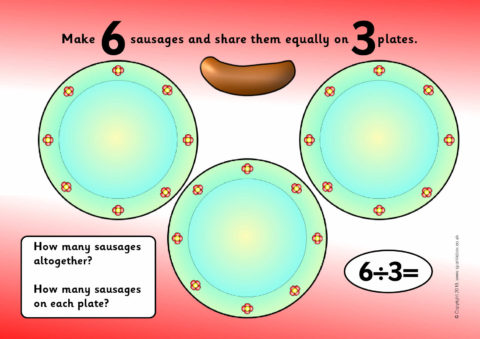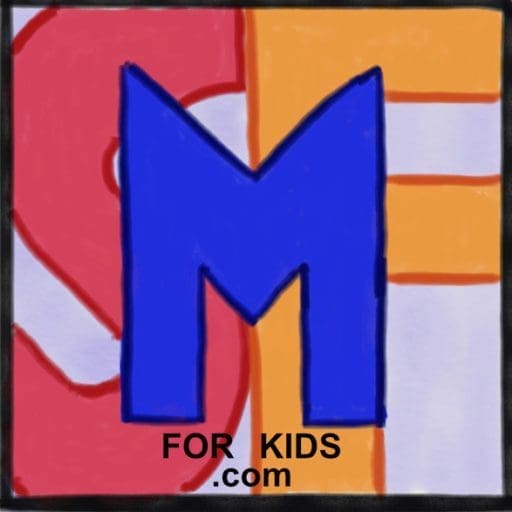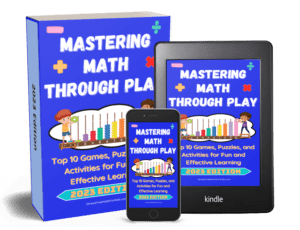One of the keys to increasing kids’ confidence and interest in math is helping them to see that math isn’t an isolated “school subject,” but something they already use every day. One of my lines in introducing division is “if you have a sibling you already know how to divide things equally!” I give them examples like “If you have 30 legos to share with your brother and sister, how many do you each get?” From there we discuss things that you might divide and make a chart: if you have cookies or candy to share, if you are splitting money, etc.
Next we go into the introductory activities below to physically divide groups and write out the corresponding equations. These go into the concept of remainder. Long division will be a separate post!
Using Food For Introducing Division
There are many plans available online for using the children’s book The Doorbell Rang to introduce division. In this book children divide cookies among themselves but more people keep coming to share the cookies! Here is a great free resource for students to follow along and make the division equations. (You can use Cookie Crisp cereal as a fun manipulative if you want).
Tales Outside the Classroom has a full explanation of an activity for introducing division using twizzlers and skittles. (she also has follow up task cards available for purchase)

The Teacher Studio has this activity using the book A Remainder of One with chocolate kisses.
Rainy Day Mum has a similar activity from a homeschool perspective. She uses the same book with pom poms instead of chocolate.
The Blue Brain Teacher uses the book Bean Thirteen and beans as manipulatives. (includes free downloadable recording sheet)
Games for introducing division
The Teacher Studio has an active large group game called The Herding Game. If you are teaching a small group or individual child, she has instructions at the bottom for playing the same game with small toy or paper animals.
The Logic Roots board game Pet Me is a favorite of many of my students as a small group activity. In this game students travel around the board adopting pets and dividing pet food equally to feed each pet in a group. It has variations for easy, moderate, and advanced players.

Divide and Conquer card game using standard playing cards. This one is a little more advanced, kids would need to be pretty familiar with division facts before playing.
Art Activities for Introducing Division
Free printable play dough mats

Relationship Between Multiplication and Division
It is incredibly important for problem solving that students fully understand the relationship between multiplication and division, that they are inverse operations. They will learn fact families in the same way that they did for addition and subtraction. After all, multiplication is repeated addition and division is repeated subtraction.) Here are some activities for practice:
Free printable templates for multiplication/division fact triangles (if you’d prefer to buy triangle cards you can get them from Amazon)

Math Geek Mama’s Number Sentence Roll and Write for Multiplication and Division
Free print and play games for practicing multiplication/division facts
Online Videos
Khan Academy Intro to Division
For Further Reading
Teaching Arithmetic: Lessons for Introducing Division Grades 3-4 is an excellent book by Marilyn Burns. Here is a review from Amazon:
“Introducing Division has been an invaluable resource in my classroom. I used the book with my 5th grade students. Some lessons recommended 2-3 days for 3rd or 4th graders, and 5th graders were able to complete the lessons and walk away with a deep understanding of concepts in just 1 day. These lessons align to CCSS for 3, 4, and as an important review for 5th graders who will need to use these basic concepts to extend division to fractions.
I taught students for 2 weeks using lessons from these books. When I finished, students were able to interpret remainders, understand divisors, dividends, and quotients. I have seen how students understand fractions as division with ease thanks to the methods in this book. Students were able to understand partial products method for division, which is similar to the standard algorithm. Some students who had already learned the “normal” way to divide, used that. I love Marilyn Burns approach of, “if you can explain the strategy, you can use it.” This allowed for lots of differentiation in class. Learning objectives aren’t clear, but they are easy to create. The experiences students will gain from working through some lessons in this book are invaluable to their mathematical development and problem solving skills.”



